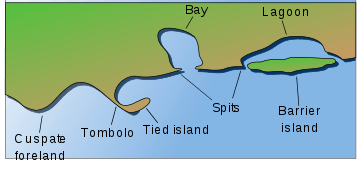Island
An island or isle is any piece of sub-continental land that is surrounded by water.[1] Very small islands such as emergent land features on atolls can be called islets, skerries, cays or keys. An island in a river or a lake island may be called an eyot or ait, and a small island off the coast may be called a holm. Sedimentary islands in the Ganges delta are called chars. A grouping of geographically or geologically related islands, such as the Philippines, is referred to as an archipelago.
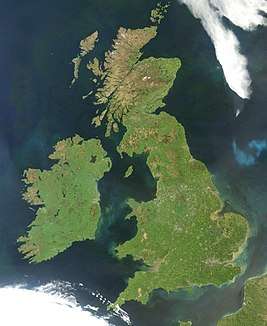
An island may be described as such, despite the presence of an artificial land bridge; examples are Singapore and its causeway, and the various Dutch delta islands, such as IJsselmonde. Some places may even retain "island" in their names for historical reasons after being connected to a larger landmass by a land bridge or landfill, such as Coney Island and Coronado Island, though these are, strictly speaking, tied islands. Conversely, when a piece of land is separated from the mainland by a man-made canal, for example the Peloponnese by the Corinth Canal, more or less the entirety of Fennoscandia by the White Sea Canal, or Marble Hill in northern Manhattan during the time between the building of the United States Ship Canal and the filling-in of the Harlem River which surrounded the area, it is generally not considered an island.
There are two main types of islands in the sea: continental and oceanic. There are also artificial islands, which are man-made.
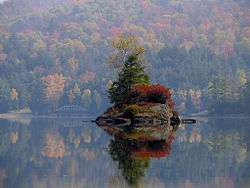

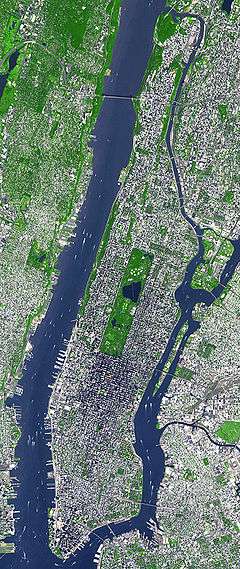

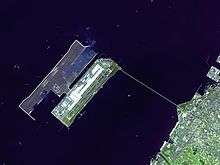
Etymology
The word island derives from Middle English iland, from Old English igland (from ig or ieg, similarly meaning 'island' when used independently, and -land carrying its contemporary meaning; cf. Dutch eiland ("island"), German Eiland ("small island")). However, the spelling of the word was modified in the 15th century because of a false etymology caused by an incorrect association with the etymologically unrelated Old French loanword isle, which itself comes from the Latin word insula.[3][4] Old English ieg is actually a cognate of Swedish ö and German Aue, and related to Latin aqua (water).[5]
Differentiation from continents
Greenland is the world's largest island, with an area of over 2.1 million km2, while Australia, the world's smallest continent, has an area of 7.6 million km2, but there is no standard of size that distinguishes islands from continents,[6] or from islets.[7]
There is a difference between islands and continents in terms of geology.[8] Continents are the largest landmass of a particular continental plate; this holds true for Australia, which sits on its own continental lithosphere and tectonic plate (the Australian plate). By contrast, islands are either extensions of the oceanic crust (e.g. volcanic islands), or belong to a continental plate containing a larger landmass; the latter is the case of Greenland, which sits on the North American plate.
Types of islands
Continental islands
Continental islands are bodies of land that lie on the continental shelf of a continent.[9] Examples are Borneo, Java, Sumatra, Sakhalin, Taiwan and Hainan off Asia; New Guinea, Tasmania, and Kangaroo Island off Australia; Great Britain, Ireland, and Sicily off Europe; Greenland, Newfoundland, Long Island, and Sable Island off North America; and Barbados, the Falkland Islands, and Trinidad off South America.
A special type of continental island is the microcontinental island, which is created when a continent is rifted. Examples are Madagascar and Socotra off Africa, New Caledonia, New Zealand, and some of the Seychelles.
Another subtype is an island or bar formed by deposition of tiny rocks where water current loses some of its carrying capacity. This includes:
- barrier islands, which are accumulations of sand deposited by sea currents on the continental shelves
- fluvial or alluvial islands formed in river deltas or midstream within large rivers. While some are transitory and may disappear if the volume or speed of the current changes, others are stable and long-lived.
Islets are very small islands.
Oceanic islands
Oceanic islands are islands that do not sit on continental shelves. The vast majority are volcanic in origin, such as Saint Helena in the South Atlantic Ocean.[10] The few oceanic islands that are not volcanic are tectonic in origin and arise where plate movements have lifted up the ocean floor above the surface. Examples are Saint Peter and Paul Rocks in the Atlantic Ocean and Macquarie Island in the Pacific.
One type of volcanic oceanic island is found in a volcanic island arc. These islands arise from volcanoes where the subduction of one plate under another is occurring. Examples are the Aleutian Islands, the Mariana Islands, and most of Tonga in the Pacific Ocean. The only examples in the Atlantic Ocean are some of the Lesser Antilles and the South Sandwich Islands.
Another type of volcanic oceanic island occurs where an oceanic rift reaches the surface. There are two examples: Iceland, which is the world's second largest volcanic island, and Jan Mayen. Both are in the Atlantic.
A third type of volcanic oceanic island is formed over volcanic hotspots. A hotspot is more or less stationary relative to the moving tectonic plate above it, so a chain of islands results as the plate drifts. Over long periods of time, this type of island is eventually "drowned" by isostatic adjustment and eroded, becoming a seamount. Plate movement across a hot-spot produces a line of islands oriented in the direction of the plate movement. An example is the Hawaiian Islands, from Hawaii to Kure, which continue beneath the sea surface in a more northerly direction as the Emperor Seamounts. Another chain with similar orientation is the Tuamotu Archipelago; its older, northerly trend is the Line Islands. The southernmost chain is the Austral Islands, with its northerly trending part the atolls in the nation of Tuvalu. Tristan da Cunha is an example of a hotspot volcano in the Atlantic Ocean. Another hotspot in the Atlantic is the island of Surtsey, which was formed in 1963.
An atoll is an island formed from a coral reef that has grown on an eroded and submerged volcanic island. The reef rises to the surface of the water and forms a new island. Atolls are typically ring-shaped with a central lagoon. Examples are the Line Islands in the Pacific and the Maldives in the Indian Ocean.
Tropical islands
.jpg)
Approximately 45,000 tropical islands with an area of at least 5 hectares (12 acres) exist.[11] Examples formed from coral reefs include Maldives, Tonga, Samoa, Nauru, and Polynesia.[11] Granite islands include Seychelles and Tioman and volcanic islands such as Saint Helena.
The socio-economic diversity of tropical islands ranges from the Stone Age societies in the interior of North Sentinel, Madagascar, Borneo, and Papua New Guinea to the high-tech lifestyles of the city-islands of Singapore and Hong Kong.[12]
International tourism is a significant factor in the economy of many tropical islands including Seychelles, Sri Lanka, Mauritius, Réunion, Hawaii, Puerto Rico and the Maldives.
Artificial islands
Almost all of Earth's islands are natural and have been formed by tectonic forces or volcanic eruptions. However, artificial (man-made) islands also exist, such as the island in Osaka Bay off the Japanese island of Honshu, on which Kansai International Airport is located. Artificial islands can be built using natural materials (e.g., earth, rock, or sand) or artificial ones (e.g., concrete slabs or recycled waste).[13][14] Sometimes natural islands are artificially enlarged, such as Vasilyevsky Island in the Russian city of St. Petersburg, which had its western shore extended westward by some 0.5 km in the construction of the Passenger Port of St. Petersburg.[15]
Artificial islands are sometimes built on pre-existing "low-tide elevation," a naturally formed area of land which is surrounded by and above water at low tide but submerged at high tide. Legally these are not islands and have no territorial sea of their own.[16]
Island superlatives
- Largest island: Greenland
- Largest island in a lake: Manitoulin Island, Ontario, Canada
- Largest lake island within a lake island: Treasure Island, in Lake Mindemoya on Manitoulin Island
- Largest island in a river: Bananal Island, Tocantins, Brazil
- Largest island in fresh water: Marajó, Pará, Brazil
- Largest sand island: Fraser Island, Queensland, Australia
- Largest uninhabited island: Devon Island, Nunavut, Canada
- Most populous island: Java, Indonesia
- Lowest island: Franchetti Island, Lake Afrera, Ethiopia
- Island shared by largest number of countries: Borneo (Brunei, Indonesia, Malaysia)
- Island with the highest point: New Guinea (Puncak Jaya, 4884 m), Indonesia
- Northernmost island: Kaffeklubben Island, Greenland
- Southernmost island (not fully surrounded by permanent ice): Ross Island, Antarctica
- Island with the most populated city: Honshu (Tokyo), Japan
- Most remote island (from nearest land): Bouvet Island
- Island with earliest known settlement: Sumatra (Lida Ajer cave), Indonesia
See also
![]()
|
|
|
References
- "Webster's Dictionary-Island". Archived from the original on October 9, 2011.
- "Hawaii : Image of the Day". Archived from the original on January 10, 2015. Retrieved January 6, 2015.
- "Island". Dictionary.com. Archived from the original on March 7, 2007. Retrieved March 5, 2007.
- Wedgwood, Hensleigh (1855). "On False Etymologies". Transactions of the Philological Society (6): 66.
- Ringe, Donald A. (2006). A Linguistic History of English: From Proto-Indo-European to Proto-Germanic. Oxford University Press. p. 109. ISBN 0-19-928413-X.
- Brown, Mike. How I Killed Pluto and Why It Had It Coming Archived April 19, 2016, at the Wayback Machine. New York: Random House Digital, 2010. ISBN 0-385-53108-7
- Royle, Stephen A. A Geography of Islands: Small Island Insularity Archived 2015-09-21 at the Wayback Machine. Psychology Press, 2001. pp. 7–11 ISBN 1-85728-865-3
- Britannica: Is Australia an Island?
- "Island (geography)". Encyclopædia Britannica. Archived from the original on October 8, 2014. Retrieved September 16, 2014.
- Lomolino, Mark V. (editor); (et al.) (2004) Foundations of Biogeography: Classic Papers with Commentaries Archived April 18, 2016, at the Wayback Machine. University of Chicago Press. p. 316. ISBN 0-226-49236-2
- Austrian Academy of Sciences. The Tropical Islands of the Indian and Pacific Oceans. doi:10.1553/3-7001-2738-3.
- Arnberger, Hertha, Erik (2011). The Tropical Islands of the Indian and Pacific Oceans. Vienna: Austrian Academy of Sciences Press. ISBN 978-3-7001-2738-3.
- "Building Artificial Islands That Rise With the Sea". Archived from the original on June 5, 2016. Retrieved June 28, 2016.
- "What Makes an Island? Land Reclamation and the South China Sea Arbitration | Asia Maritime Transparency Initiative". July 15, 2015. Archived from the original on May 27, 2016. Retrieved June 28, 2016.
- "Conception of development of the artificial lands of Vasilievsky island". Archived from the original on September 25, 2016. Retrieved June 28, 2016.
- United Nations Convention on the Law of the Sea, Article 13. Archived from the original on September 2, 2017. Retrieved August 25, 2017.
External links
| Wikimedia Commons has media related to: |
| Wikiquote has quotations related to: Islands |
| Wikisource has the text of the 1911 Encyclopædia Britannica article Island. |
- Definition of island from United Nations Convention on the Law of the Sea
- Listing of islands from United Nations Island Directory.
